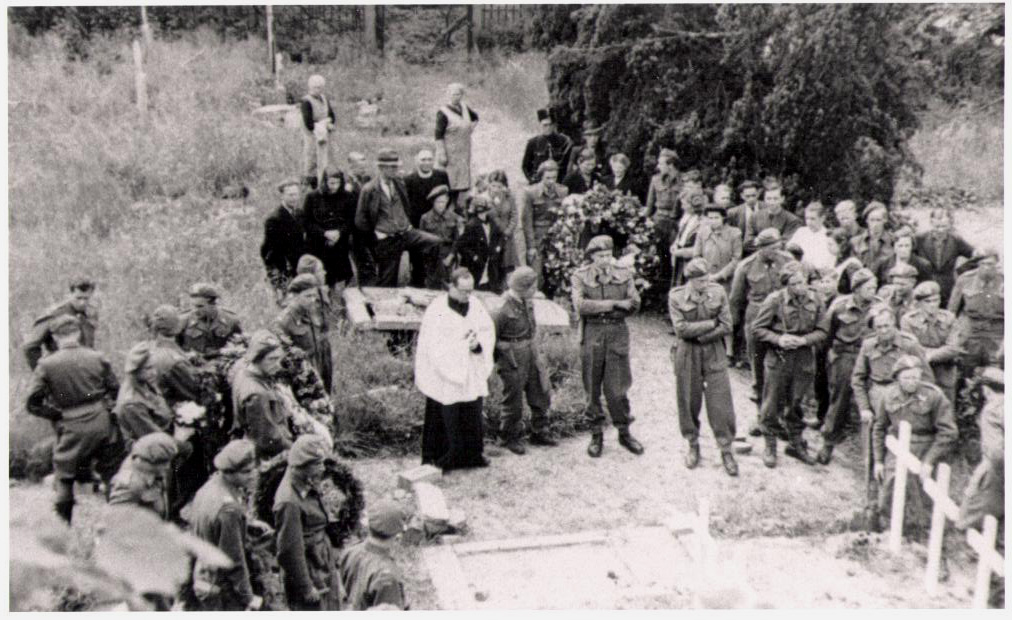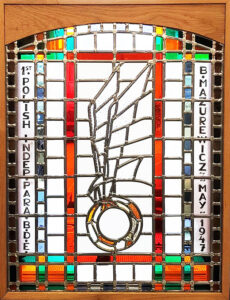Download PDF version
Bound by friendship and gratitude
The history of RKSV Driel is closely associated with the history of the village and the Polish paratroopers who fought there in 1944. This can be seen in the colours of the club and its logo. In gratitude for Driels’s support, the football club is sponsoring the restauration of a clear piece of this history.

Photo: The Polish Institute and Sikorski Museum
Driel became a scene of battle
Thursday 21 September 1944 the parachutists of the 1st Polish Independent Parachute Brigade came down from the sky to the complete surprise of the people of Driel.
They landed as part of Operation Market Garden that had as its objective the capture of the main bridge in Arnhem.
The presence of the Polish military drew enemy fire. People were forced to evacuate. When they returned after the war they found many houses and other buildings severely damaged or completely destroyed as a result of the fights with German troops.
The photo shows the former Catholic boys school situated on what is now called the Korte Molenstraat. During the fighting the Poles set up an emergency hospital in this building. One direct German hit marked the end of this school building.

Photo: The Polish Institute and Sikorski Museum
The Battle of Arnhem came to an end on 26 September and the Poles withdrew from the village in the direction of Nijmegen. They left Driel, but not with their hearts. This was clear and could be felt in the years to come and now the annual commemoration also shows this convincingly.
Thirty parachutists died in and around the village. Most of them were buried during the battle by their comrades in the graveyard of the Roman Catholic church. In May 1945, after a short ceremony, they were reburied at the same graveyard. Their comrades placed a white cross on the graves. This can be seen in the photo below. Representatives of the local population were present. In the background Father Poelman – the local parish priest – can be seen, recognisable by his white collar.
During Operation Market Garden 98 soldiers of the parachute brigade perished, of which 79 are buried at the Oosterbeek War Cemetery. Amongst them the 30 bodies from Driel who were reburied in Oosterbeek in 1946. Nineteen others are buried elsewhere in The Netherlands or in Belgium but there were those who were never found.
After the war the Polish veterans felt troubled by what had happened to the village as a result of their presence in September 1944. These feelings were put clearly into words in a tribute to the people of Driel. In 1947, the commander of the 1st Polish Independent Parachutist Brigade, for example, wrote:
“We did not know you. As ordered we flew to a place where there was fighting in a strange country. By you we found a heart that gave us the feeling that we were amongst good people. In those days of heavy fighting with the enemy that brought ruins with it, you gave us a feeling of help, care and support as if we were close relatives.
We gave you a bitter feeling of freedom that did not last long. And we were not in a position to heal the deep wounds that were brought by our fight but that were not brought on by us. Your school provided a retreat for our wounded soldiers, which resulted in its severe destruction. By destroying the school, which was for us a hiding place for those who could not defend themselves, for you the place where the lives of your children would be developed.”
Veterans are grateful
The Polish parachutists were impressed by the way the people of Driel welcomed them after the war. As clear evidence of their closeness to Driel, in 1947 the veterans collected money to rebuild the school that had been destroyed as a result of the war. This initiative brought in – for that time – the enormous sum of 6,500 guilders which in current day terms would be Euro 30,000. The school board used this money to finance the central heating system in the renewed school building.
On the 19 May 1947, the Polish veterans offered a stained-glass window as contribution to the restoration of the school. In the window, a diving eagle can be seen, the symbol of the Polish paratroopers. This was placed in the front of the semi-permanent boys school which came into use on 30 May 1948. This gift from the veterans provides a symbol of their contribution to the redevelopment.
The new Stanislaus school on the Patrijsstraat was inaugurated on 13 November 1958. The stained-glass window was given a prominent place in the central hall. After the merger of catholic schools the building was used for public education and the window was relocated at the parish centre. A photo of this window can be seen at the end of this article.
Driel grateful
From the people of Driel – who saw the Polish soldiers as “our liberators” – came the initiative to express gratitude to the veterans. In December 1946, the school children of Driel – helped by the Committee Driel-Poland – sent Christmas greetings to all the Polish parachutists who had fought in Driel in 1944. This Christmas card can be seen below.
In gratitude for the effort made by the Poles, the Polish St. Stanislaus was chosen as the patron saint of the school.
The street that was constructed alongside the renovated school building was given the name of a former Polish king Casimir.
On 19 October 1945, Father Poelman – earlier referred to – played an important role in the setting up RKSV Driel as an independent sports club. The football club chose white and red for their sports clothes – the colours of the Polish flag -as an expression of their honour for the Polish veterans. In 1985, marking its 40 years existence, a logo was added that showed a parachutist as a reference to the Poles.
This year – 2020 – the football club has been in existence for 75 years. The club decided in gratitude to the peoples support of the club throughout the years, to undertake the necessary restauration of the stained-glass window, a permanent gift to the village.
Now, after the restauration, it has been given a place at the back of the Roman Catholic church in the Information Centre in grateful memory of the contribution of the Polish soldiers to peace.
Rob Snelders,
On behalf of Foundation Driel-Polen
Download PDF version



